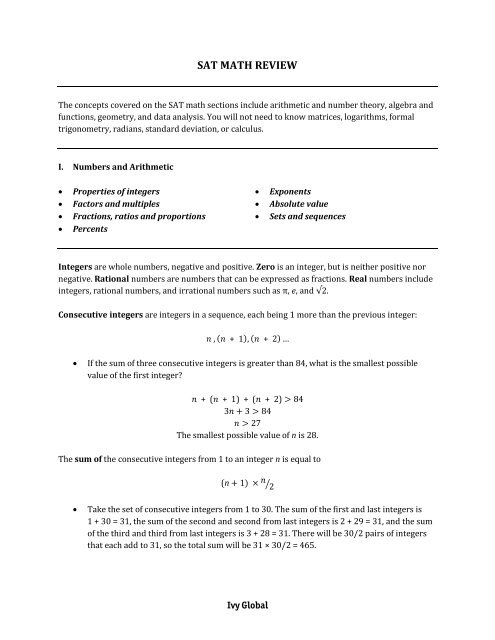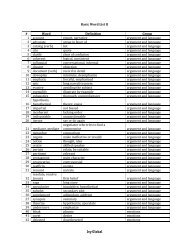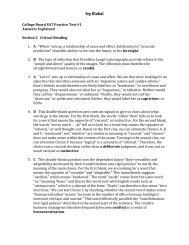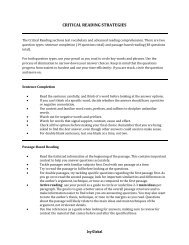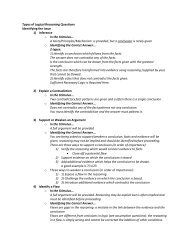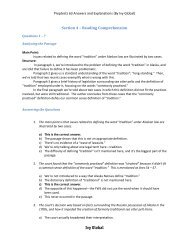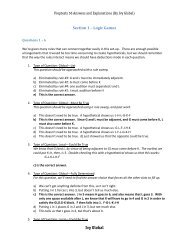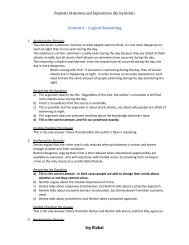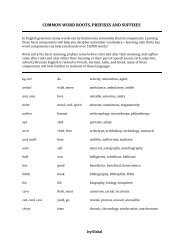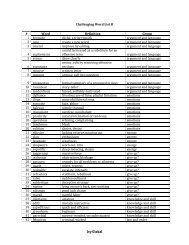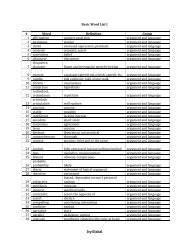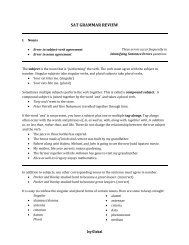SAT MATH REVIEW - Ivy Global
SAT MATH REVIEW - Ivy Global
SAT MATH REVIEW - Ivy Global
Create successful ePaper yourself
Turn your PDF publications into a flip-book with our unique Google optimized e-Paper software.
A book has been discounted 15% and its current price is $12. What was its original price?x − $12× 100% = 15%xx − $12 = 0.15x0.85x = $12x = $14.12Exponent notation indicates that a number is being multiplied by itself. The number is the baseand the number of times it is being multiplied is the exponent. Exponents follow standard rules:a 1 = aa 0 = 1a −m = 1a ma m a n = a m+na m= am−nan (a m ) n = a mna m b m = (ab) ma mb m = ( a b )ma m nn = a m4 1 = 44 0 = 14 −2 = 1 4 24 2 × 4 3 = 4 54 54 2 = 43(4 2 ) 3 = 4 64 2 × 3 2 = (4 × 3) 24 23 2 = (4 3 )24 4 55 = 4 4 If 5 x 2 = 5 a × 5 b , then what is x in terms of a and b?5 x 2 = 5 x5 a × 5 b = 5 a+b5 x = 5 a+bx = a + bThe absolute value of a number is its distance away from 0 on a number line. The absolute valuewill always be positive.If x = 4, then x = 4 or x = −4If x < 4, then − 4 < x < 4If x > 4, then x < −4 or x > 4<strong>Ivy</strong> <strong>Global</strong>
the pattern. You will never be asked to derive the formula for a sequence, but you may need to dosomething of the sort in order to answer the questions. Keep in mind:If a 1 is the first term of an arithmetic sequence, d is the common difference between terms,and n is the number of terms, thena n = a 1 + d(n – 1)If a 1 is the first term of a geometric sequence, r is the common ratio between terms, and n isthe number of terms, thena n = a 1 (r) n−1Each term in a sequence is 3 times the preceding term. If the first term is 2, what is theaverage of the 5 th and 7 th terms?a 7 = 2 × 3 6 = 1458a 5 = 2 × 3 4 = 162The average of the two terms is1458 + 162= 8102Some sequences are neither arithmetic nor geometric. Establish a pattern, but don’t waste yourtime trying to find an algebraic formula for these!1, 4, 5, 9, 14, 23, 37: each term is the sum of the previous two terms.4, 6, 9, 3, 4, 6, 9, 3: the terms repeat cyclically.A lane divider in a swimming pool has 77 flags strung in a row. The colours repeat in apattern: red, blue, green, red, blue, green, red, blue, green ... If the first flag is red, whatcolour is the last flag?The three colours will repeat themselves 77/3 = 25.66667 times, or 25 times with tworemainders. Following the pattern, these last two flags will be red and blue, respectively.Thus, the last (77 th ) flag is blue.II. Algebra and FunctionsOperations involving polynomialsEquations and systems of equationsProperties of inequalitiesWord problemsFunctions and their domains, rangesStrange symbolsLinear and quadratic graphsGraph behaviour and translations<strong>Ivy</strong> <strong>Global</strong>
To represent the relationship between their ages last year, subtract 1 from each of theircurrent ages:a − 1 = 2(j − 1)Solve for j:a = 17 − j17 − j − 1 = 2(j − 1)16 − j = 2j − 218 = 3jj = 6Jake is currently 6 years old.An event has two admission prices: adult tickets are $10 each and student/senior ticketsare $8 each. The ticket office has sold 77 tickets totalling $686. How many adult tickets weresold?Key words: each, totallingLet a represent the number of adult tickets and s represent the number of student/seniortickets:a + s = 77To represent total revenue, multiply each type of ticket by its price:10a + 8s = 686Solve for a:s = 77 − a10a + 8(77 − a) = 68610a + 616 − 8a = 6862a = 70a = 35There were 35 adult tickets sold.You can often solve a word problem involving rates with the following equation:distance = rate × timeAn airplane flew from Mississippi to California. On the return trip from California toMississippi, its average speed was reduced by 50 miles per hour and the resulting flight was110longer than the original. What is the airplane’s original average speed from Mississippi toCalifornia?Let d be the distance, r be the airplane’s original speed and t be the time, in hours, of itsflight from Mississippi to California.<strong>Ivy</strong> <strong>Global</strong>
d = r × tFor its return trip, over the same distance, its speed is 50mph less and its time is 1 10 greater:Solve for r:d = r − 50 × 1110 tr × t = r − 50 × 1110 tr = (r − 50) × 1110r = 11 r − 55101r = 5510r = 550The plane's original speed was 550 mph.Adam can paint a house in 6 hours. When Karen comes to work, the two together can painta house in 4 hours. Assuming that both work at a constant rate alone and together, how longdoes it take Karen to paint a house alone?We will use the same equation, but the distance d will represent the number of housespainted.d = r × tLet Adam’s rate be r a . He paints 1 house in 6 hours:1 = r a × 6r a = 1 6Let Karen’s rate be r k . Their rate together is (r a + r k ). Together, they paint the same housein 4 hours:1 = r a + r k × 4As Adam’s rate is 1 6 , we can solve for r k:1 = ( 1 6 + r k) × 416 + r k = 1 4r k = 112Karen’s rate is 1houses per hour, so she can paint 1 house in 12 hours.12<strong>Ivy</strong> <strong>Global</strong>
A function is a rule that associates one set of numbers with another dependent set of numbers. Thefunction f x = x + 1 tells us that every real number x is assigned to the corresponding numberx + 1. If you are asked to find f 3 , simply follow the rule connecting 3 to its assigned number:f 3 = 3 + 1 = 4. If x = 3x 2 − 2x , what is f 1 2 + f 1 ?2f 1 2 = 3 1 2− 2 1 2 = 3 4 − 1 = − 1 4f 1 = 3 1 2 − 2 1 = 3 − 2 = 1f 1 2 + f 1 = − 1 4 + 1 = 3 4 If f x = 3x 2 − 2x, what is f(x 2 )?f x 2 = 3(x 2 ) 2 − 2(x 2 ) = 3x 4 − 2x 2If f x = 3x 2 − 2x, what is f(f(2))?f 2 = 3 2 2 − 2 2 = 12 − 4 = 8f 8 = 3 8 2 − 2 8 = 192 − 16 = 176f f 2 = 176The domain of a function is the set of all the numbers for which the function is defined—that is, allthe “input” numbers for which the function still works. The range of a function is the set of all the“output” numbers. What is the domain of the function x = (x + 2) 1 2 ?f x = (x + 2) 1 2 = x + 2Because we can’t take the square root of a negative number, we know that x + 2 can’t benegative:x + 2 ≥ 0x ≥ −2 What number is not in the domain of the function f x = 1x 2?We can take the square of any real number x, but we can’t divide by zero. Therefore:<strong>Ivy</strong> <strong>Global</strong>
x 2 ≠ 0x ≠ 0Zero is the only number not in the domain of our function.Instead of using function notation to represent the relationships between sets of numbers, the <strong>SAT</strong>will often use strange symbols: smiley faces, stars, bubbles, etc. Treat these the same way youwould treat function questions—look for the rule, and figure out how you should apply it. For all negative values x, let x = 4x + 7. For zero and all positive values x, let x = 3x 2 .What is the value of (-1)? −1 = 4 −1 + 7 = 3 3 = 3 3 2 = 27 −1 = 27For all non-zero numbers a and b, let be defined asa b = 2a bIf 3 4 = x 2, what is the value of x?3 4 = 2 × 34= 6 4x 2 = 2x 2 = x64 = xx = 3 2Let x represent the number of factors of any real number x. For example, 6 = 4 because6 has four factors: 1, 2, 3 and 6. What is 9?9 has three factors: 1, 3, and 9. Therefore, 9 = 3.The graph of a function is the collection of all ordered pairs (x, y)where y = f x . Thus, the graphof f x = x + 1 is the line y = x + 1. You will never be asked to draw a graph on the <strong>SAT</strong>, but youmay need to derive an equation or function based on a graph.<strong>Ivy</strong> <strong>Global</strong>
Linear functions can be represented in the form y = mx + b, where m is the slope and b is they-intercept. Remember the formula for calculating slope:m = riserun = y 2 − y 1x 2 − x 1Facts about slope: Horizontal lines have slopes of zero. Vertical lines have undefined slopes. Non-vertical parallel lines have equal slopes. Non-vertical perpendicular lines have slopes whose product is -1. A line with a slope of 5 passes through the points (k, 7) and (-1, -3). What is the value of k?5 = y 2 − y 1= −3 − 7x 2 − x 1 −1 − k5 −1 − k = −10−1 − k = −2k = 1In the xy-coordinate plane, line h has a slope of 2 and is perpendicular to line g. If line gpasses through the origin and intersects line h at the point (a, 3 + a), what is the value of a?Let m represent the slope of line g. Line g and line h are perpendicular, so:2m = −1m = − 1 2We know that line g passes through the origin, so its y-intercept is 0. Its equation must be:y = − 1 2 xPlug the point (a, 3 + a) into this equation to solve for a:3 + a = − 1 2 a3a = −32a = −2Quadratic functions can be represented in the form y = ax 2 + bx + c, where c is the y-intercept.The sign of a determines whether the parabola opens upwards (a is positive) or downwards (a is<strong>Ivy</strong> <strong>Global</strong>
negative). You can often find the x-intercepts of a parabola by factoring; the <strong>SAT</strong> will never requireyou to use the quadratic formula.The vertex of a parabola is its lowest or highest point. If we call the coordinates of the vertex (h, k),then: = −b2aWhen asked to solve for other points on a parabola, remember that a parabola is symmetricalabout the vertical line through its vertex.In the figure below, f x = x 2 − 1 and g x = −x 2 + c, where c is a constant. The twofunctions intersect at points A and B. If AB = 4, what is the value of c?Because a parabola is symmetrical and AB = 4,each point of intersection must be 2 units awayfrom the y-axis. Thus, we can call theircoordinates (-2, y) and (2, y). Solve for y byplugging one of these points into the firstequation:Ayg(x) = -x 2 + cBf x = x 2 − 1y = 2 2 − 1y = 3f(x) = x 2 - 1xThe two equations intersect at (-2, 3) and (2, 3).Plug one of these points into the second equationto solve for c:g x = −x 2 + c3 = −2 2 + cc = 7You may be asked to analyze the behaviour ofgraphs without knowing or using their equations.The graph of y = f(x) is shown below. Iff 2 = d, what is f d ?f 2 = 4, so d = 4f d = f 4 = 0108642y0x0 2 4 6 8 10<strong>Ivy</strong> <strong>Global</strong>
A translation of a graph is a rigid shift vertically or horizontally that does not change the size orshape of the graph. For the graph of y = f(x), a vertical translation of a units and a horizontaltranslation of b units results in the equationy − a = f(x − b)Let’s begin with the graph of y = x 2 . If we shift vertically 3 units and horizontally 2 units, we gety − 3 = (x − 2) 2 . If we shift vertically -3 units and horizontally -2 units, we get y + 3 = (x + 2) 2 .yyy = x 2xy - 3= (x - 2) 2xyxy + 3 = (x + 2) 2Below are the graphs of the functions f x = x 3 − 2x and g x = f x − c + d, where c andd are both constants. What is the value of d + c?yyy = f(x)y = g(x)(1, 5)(-1, 1)(3, 3)(1, -1)xx<strong>Ivy</strong> <strong>Global</strong>
In the equation y − a = f(x − b), a represents the vertical shift and b represents thehorizontal shift. Re-write the equation of g(x) to look similar:g x − d = f x − cHere, d represents the vertical shift and c represents the horizontal shift. By comparing thetwo points given on the graph, we can see that the graph has been translated 2 unitshorizontally and 4 units vertically. Thus:c = 2d = 4d + c = 6III. GeometryPoints, lines, and anglesTriangles and special trianglesPolygons and quadrilateralsCirclesSolid geometryCoordinate geometryAny two distinct points can be connected by one and only one line. A midpoint is the point thatdivides a line segment into two equal parts. You may be asked to find the length of a line segment orthe ratio of one line segment to another. You may also need to find the order of points along acommon line.Points A, B, C, D, and E lie on a line, not necessarily in that order. B is the midpoint of AD, C isthe midpoint of AB, and D is the midpoint of BE. If AC = 4, what is the value of CE?Begin by drawing a diagram to put the points in the correct order. B is the midpoint of AD:C is the midpoint of AB:D is the midpoint of BE:<strong>Ivy</strong> <strong>Global</strong>
We know that AC = 4, so we can write in the length of each line segment:Adding together the component line segments, we find that CE = 20.An angle is formed when two lines or line segments intersect. Know the following definitions:An angle measuring less than 90° is an acute angle.An angle measuring 90° is a right angle.An angle measuring between 90° and 180° is an obtuse angle.An angle measuring 180° is a straight angle.Know also the following angle sums: The sum of any number of angles that form a straight line is 180°. The sum of any number of angles around a point is 360°. Two angles that add to 90° are called complementary angles. Two angles that add to 180° are called supplementary angles.Complementary AnglesSupplementary AnglesA line that bisects an angle divides it into two equal parts. In the following diagram, if x = y, thenline l bisects ∠ABC:<strong>Ivy</strong> <strong>Global</strong>
Vertical angles are the opposite angles formed by two intersecting lines. These are congruent:a = d and b = c.If two lines are parallel, they will never intersect. We can determine that two lines are parallel ifthere is a third line that is perpendicular to both of them:If a third line (transversal) intersects a pair of parallel lines, it forms eight angles. Know thefollowing relationships:The pairs of corresponding angles are congruent: a = e, b = f, c = g, and d = .The pairs of alternate interior angles are congruent: c = f and d = e.The pairs of alternate exterior angles are congruent: a = and b = g.The pairs of consecutive interior angles are supplementary: c + e = 180° andd + f = 180°.<strong>Ivy</strong> <strong>Global</strong>
In the diagram below, five lines intersect in a point to form five angles. If y = 2x, what is thevalue of x?The sum of angles around a point is 360°:x + 3x + y + 2y + 4y = 3604x + 7y = 360y = 2x, so we can substitute and solve for x:4x + 14x = 36018x = 360x = 20In the diagram below, line n is perpendicular to both line l and line m, and line p bisects∠RST. What is the value of x?Because line n is perpendicular to both land m, we can conclude that l and m areparallel lines.Line p bisects ∠RST, a right angle, anddivides it into two angles of 45° each. Wecan label these on the diagram.Because line p intersects two parallellines, we know that pairs of consecutiveinterior angles are supplementary.Therefore:x + 45 = 180x = 135<strong>Ivy</strong> <strong>Global</strong>
Triangle geometry is the most commonly tested geometry topic on the <strong>SAT</strong>.The sum of the interior angles of a triangle is 180°. An exterior angle is an angle that is formed byextending one side of the triangle. An exterior angle of a triangle is equal to the sum of the twoopposite interior angles. In the following diagram, a + b + c = 180 and d = a + b.Triangles can be classified by interior angles and side lengths: An acute triangle has three acute angles. An obtuse triangle has one obtuse and two acute angles. A right triangle has one angle measuring 90°. An equilateral triangle has three congruent sides and three congruent angles. All three ofthese angles measure 60°. An isosceles triangle has two congruent sides and two corresponding congruent angles. A scalene triangle has three sides of different lengths and three angles of differentmeasures.In the figure to the right, ∆ABC is an equilateraltriangle, ∆EFC is a right triangle, and DF = EF. If themeasure of ∠DFE is 20°, what is the value of x?Fill in as many of the angle measures as possible withthe given information. ∆ABC is an equilateral triangle,so each of its interior angles measures 60°.<strong>Ivy</strong> <strong>Global</strong>
DF = EF, so ∆DFE is isosceles and ∠FDE ≅ ∠FED.Because ∠DFE measures 20° and the interior anglesof a triangle must add to 180°, we can conclude that∠FDE and ∠FED each measure 80°.Finally, ∠EFC measures 90° and ∠ECF measures60°, so ∠CEF must measure 30°.We now have all the information necessary to solvefor x, which lies on a straight line with two otherangles:x + 80 + 30 = 180x = 70The hypotenuse of a right triangle is the side opposite the right angle. If the two legs of a righttriangle have lengths a and b and the hypotenuse has a length c, then the Pythagorean Theoremstates thata 2 + b 2 = c 2Special right triangles have a set ratio among the lengths of their sides, derived from thePythagorean Theorem. A triangle with angles of 30°-60°-90° has a short leg measuring x, a long leg measuring x 3,and a hypotenuse measuring 2x. A triangle with angles of 45°-45°-90° has two legs that each measure x and a hypotenusemeasuring x 2. A 3-4-5 right triangle is a right triangle whose sides are in the ratio 3:4:5.<strong>Ivy</strong> <strong>Global</strong>
In the diagram to the right, ∆ABC is a righttriangle, ∠BDC is a right angle, ∠DC Bmeasures 30°, and AD = 1. What is theperimeter of ∆ABC?∆ABC, ∆ADB, and ∆BDC are all 30°-60°-90°triangles. Because the length of AD isgiven, we can find the lengths of AB:AD = 1AB = 2From the length of AB, we can find thelengths of BC and AC:AB = 2BC = 2 3AC = 4The perimeter of ∆ABC is 2 + 2 3 + 4 =6 + 2 3.The triangle inequality states that the sum of the lengths of two sides of a triangle is alwaysgreater than the length of the third side.If two sides of a triangle measure 4 and 6 units, what could be the length of the third side?Using the triangle inequality, we know that the length of third side must be less than 10units:4 + 6 > x, so 10 > xWe also know that the lengths of the third side plus either one of the other sides must begreater than the length of the remaining side:x + 4 > 6, so x > 2x + 6 > 4, so x > −2The length of the third side must be greater than 2 but less than 10 units.If b represents a triangle’s base and h represents its height, the area of a triangle isA = 1 2 b<strong>Ivy</strong> <strong>Global</strong>
Congruent triangles are the same shape and size: they have corresponding congruent angles andcongruent sides. We can prove that two triangles are congruent by any of the following means:Side-side-side: the corresponding sides are congruentSide-angle-side: two corresponding sides and the angles they form are congruentAngle-side-angle: two corresponding angles and the sides between them are congruentSimilar triangles have the same shape but different sizes. Their corresponding angles arecongruent, and their corresponding sides are proportional. We can prove two triangles are similarif two corresponding angle pairs are congruent, or if one corresponding angle pair is congruent andthe adjacent sides are proportional.Similar Triangles<strong>Ivy</strong> <strong>Global</strong>
In the diagram to the right, ∆ABC is a right triangle,∠C measures 45°, and BC = 4. If D is the midpoint ofAB and E is the midpoint of BC, what is the length ofDE?All interior angles of a triangle add to 180°, so ∠A alsomeasures 45°. ∆ABC a 45°-45°-90° triangle and anisosceles triangle, so AB = 4 as well.D is the midpoint of AB and E is the midpoint of BC,so BE and BD each measure 2 units. Because BE andBD are each half of AB and BC, and both pairs formthe same right angle, we can conclude that ∆ABCand ∆DBE are similar triangles. Thus, ∆DBE isalso a 45°-45°-90° triangle.If each of the legs of ∆DBE measure 2 units, thenthe hypotenuse must measure 2 2 units.DE = 2 2A polygon is an enclosed shape with straight sides. A regular polygon has congruent sides andcongruent interior angles. For a polygon with n sides, the sum of the interior angles is180°(n − 2)A quadrilateral is a four-sided polygon. The sum of the interior angles of a quadrilateral is 360°.A parallelogram is a quadrilateral with two pairs of parallel sides. Rhombuses, rectangles, andsquares fall into this category. The opposite sides of a parallelogram are congruent in length and theopposite angles are congruent in measure. Adjacent angles are supplementary. Each diagonaldivides the parallelogram into two congruent triangles. The two diagonals are not necessarily thesame length, but they bisect each other.<strong>Ivy</strong> <strong>Global</strong>
If b represents the base of the parallelogram and h represents its height (perpendicular to the base),then the formula for the area of any parallelogram isA = bA rhombus is a quadrilateral whose four sides are all the same length. All rhombuses are alsoparallelograms and have the same properties. Additionally, the diagonals of a rhombus are alwaysperpendicular and bisect their interior angles.A rectangle is a quadrilateral with four right angles. All rectangles are also parallelograms andhave the same properties, but the diagonals of a rectangle are the same length.<strong>Ivy</strong> <strong>Global</strong>
The area of a rectangle is simply its base multiplied by its height. If its length is l and its width is w,then the perimeter of a rectangle isP = 2(l + w)A square is a regular quadrilateral—that is, all four sides and all four angles are the same measure.Squares are both rectangles and rhombuses. The diagonals of a square are of equal length andperpendicular, and they bisect its interior angles. The diagonals divide the square into congruent45°-45°-90° triangles.If the length of a side is s, then the area of a square is s 2 and the perimeter is 4s.A trapezoid is a quadrilateral with only one pair of parallel sides. An isosceles trapezoid has twopairs of congruent angles, and its two non-parallel sides are congruent.If a and b are the lengths of the parallel sides and h is the height perpendicular to these sides, thenthe area of a trapezoid isA = 1 (a + b)2<strong>Ivy</strong> <strong>Global</strong>
What is the area of the square shown to the right?We know that a diagonal of a square divides it into 45°-45°-90°triangles, with sides of length x and a hypotenuse of length x 2.Here, the hypotenuse is 16 units long, so we can find the length ofeach side:x 2 = 16x = 16 2 = 16 22= 8 2If each side is 8 2 units long, then the area of the square is(8 2) 2 = 128In the quadrilateral ABCD to the right, AB is parallel toCD, BD is perpendicular to CD, and ∠C measures 60°. IfBD = 4 3 and AB = 2, what is the area ofquadrilateral ABCD?If we drop another line from point A perpendicular toCD, we can break up the trapezoid into a rectangle anda triangle. The rectangle has side lengths 2 and 4 3,and the triangle is a 30°-60°-90° triangle with a longside of length 4 3. Because we know that a 30°-60°-90°triangle has a short side of length x and a long side oflength x 3, we can solve for the short side:Figure not necessarily drawn to scalex 3 = 4 3x = 4We now know that the trapezoid ABCD has a shortbase of length 2, a long base of length 6, and a heightof 4 3. The area of the trapezoid isA = 1 a + b2A = 1 2 4 3 2 + 6 = 16 3<strong>Ivy</strong> <strong>Global</strong>
A circle is a set of all points in a plane that are the same distance from a given point. This distance,from the centre of the circle to any point on the circle, is called the radius. All radii of one circle arethe same length. A line connecting two points on the circle and passing through the centre is calleda diameter. The diameter of a circle is equal to twice the length of the circle’s radius.If d is the length of the diameter and r is the length of the radius, the circumference of a circle isC = πd = 2πrIf r is the length of the radius, the area of a circle isA = πr 2An arc is a segment of the circumference of a circle. Arcs aremeasured either in degrees or in units of length. Drawing two radiifrom the endpoints of the arc to the centre of the circle creates thearc’s central angle, whose degree measure is equal to the degreemeasure of the arc. The ratio between the length of the arc and thecircumference of the circle is equal to the ratio between the degreesin the central angle and the degrees in the entire circle. If the arc’scentral angle measures x° and the arc’s length is L, then:L2πr = x°360°A sector is a region of a circle bounded by two radii and an arc. The ratio between the area of asector and the area of the entire circle is also equal to the ratio between the degrees in the centralangle and the degrees in the entire circle. If the sector’s central angle measures x° and the sector’sarea is A, then:Aπr 2 =x°360°A line that intersects a circle at exactly one point is called atangent. The radius drawn from the point of intersectionto the centre of the circle is always perpendicular to thetangent.<strong>Ivy</strong> <strong>Global</strong>
If every vertex of a polygon lies on a circle, then the polygon is said to be inscribed in the circle. Ifeach side of a polygon is tangent to a circle, then the circle is inscribed in the polygon.In the figure to the right, BC is an arc of a circle whose centre isA. If the length of arc BC is 2π units, what is the area of sectorABC?The central angle of arc BC is 60°, which is 60= 1 of the total360 6degrees of the circle. The length of the arc is 2π units, whichmust be 1 the total circumference of the circle. Thus, the6circumference must be 12π units. We can use thecircumference to solve for the radius:C = 2πr12π = 2πrr = 6If the radius is 6 units, the area of the entire circle is 36π units squared. The area of sectorABC is 1 the total area of the circle, so the area of ABC must be 6π units squared.6In the figure to the right, square GHIJ is inscribed in a circlewhose centre is K. If the area of square GHIJ is 16, what isthe area of circle K?The area of the square is 16, so the length of each sidemust be 16 = 4.Drawing a diagonal of the square divides it into two 45°-45°-90° triangles. If each side of these triangles has alength of 4, then the length of the hypotenuse must be 4 2.<strong>Ivy</strong> <strong>Global</strong>
This hypotenuse is also a diameter of circle K. If itslength is 4 2, then the radius of circle K has a length of2 2. The area of circle K is π(2 2) 2 = 8π.Solid geometry is concerned with figures in three dimensions: rectangular solids, prisms,cylinders, pyramids, cones and spheres. Though all of these solids may appear on the <strong>SAT</strong>, you willprimarily be working with rectangular solids, prisms, and right cylinders.A rectangular solid has six rectangular faces that intersect at right angles. The surface area of arectangular solid is the sum of the areas of all six of itsrectangular faces. The volume of a rectangular solid is itslength multiplied by its width multiplied by its height.V = lwSA = 2lw + 2w + 2lA cube is a rectangular solid formed by six congruent squares—thelength, width, and height are equal. If s is the length of the cube’s side,thenV = s 3SA = 6s 2The diagonal of a rectangular solid joins opposite vertices—it is the longest line that can be drawnthrough the solid. For a rectangular solid with length l, width w, height h, and diagonal d:d 2 = l 2 + w 2 + 2<strong>Ivy</strong> <strong>Global</strong>
A prism is any solid with two congruent bases joined byperpendicular rectangles. A rectangular solid is a type ofprism. A triangular prism has triangles as bases, an octagonalprism has octagons as bases, and so on. The volume of a prismequals the area of its base multiplied by its height.A right cylinder is similar to a prism: it has two circular bases connected by aperpendicular curved surface. The volume of a cylinder is equal to the area of itsbase multiplied by its height. The surface area of a cylinder is the sum of theareas of its bases and the area of the curved rectangle that connects them; thetwo sides of this rectangle are the cylinder’s height and the circumference of thebase. If r is the radius of a cylinder’s base and h is its height, thenV = πr 2 SA = 2πr 2 + 2πrOther solids incude spheres, cones, and pyramids. You will not be requred tomemorize the formulas for volume and surface area of these solids.A sphere is the collection of all points in space that are the same distanceaway from a centre point. All radii of a sphere are equal.A cone has a circular base and a curved surface thattapers to a point, called the vertex. In a right circularcone, the line connecting the vertex to the centre ofthe base forms a right angle with the base.A pyramid has a polygon for a base and triangularfaces that join in a point, called the vertex. A regular pyramid has aregular polygon for its base and congruent isosceles triangles for its sides.A net is a figure in a plane formed by “unfolding” a solid along its edges. Nets can help you calculatesurface area. The following is the net of a cylinder:<strong>Ivy</strong> <strong>Global</strong>
The figure to the right shows a cubic box with a side lengthof 2. A rectangular piece of metal has been inserted into thebox at a slant, so the bottom edge CD intersects the insidefront edge of the cube. If points A and B are midpoints ofthe top edges of the cube, what is the area of the rectangleABCD?We know the length of AB and CD are each 2, but we needto find the lengths of AC and BD. We can see that BD forms aright triangle with two of the edges of the cube. We’ll callthe third point on this triangle point E.The side length of the cube is 2, so DE = 2. We know thatB is the midpoint of one of the upper sides, so BE = 1. Wecan solve for BD using the Pythagorean Theorem:(BD) 2 = 2 2 + 1 2BD = 5The area of rectangle ABCD is 2 × 5 = 2 5.A spherical ball is completely inscribed within a cube whose volume is 64 cubed inches.What is the radius of the ball?Let’s draw a figure. If the sphere is inscribed within the cube,the diameter of the sphere is equal to the width of the cube.We know the cube’s volume is 64 cubed inches, so the length3of each side of the cube is 64 = 4 inches. The diameter ofthe sphere is 4 inches, so its radius must be 2 inches.A hollow cylinder 5 centimeters long is formed so that the circular opening on each side hasa diameter of 3 centimeters. The outside of the cylinder is to be painted red. What is thetotal surface area of paint needed?The outside of the cylinder is simply a rectangle whose dimensionsare equal to the height of the cylinder and the circumference of thecircular base. The height is 5 centimeters long, and the<strong>Ivy</strong> <strong>Global</strong>
circumference of the base is πd = 3π centimeters. The area of the surface to be painted is5 × 3π = 15π centimeters squared.Coordinate geometry deals with figures in the coordinate plane. You may need to calculate theslope or length of lines, or the area or perimeter of polygons given their coordinate points.Keep in mind (from the Algebra and Functions section): Horizontal lines have slopes of zero. Vertical lines have undefined slopes. Non-vertical parallel lines have equal slopes. Non-vertical perpendicular lines have slopes whose product is -1.We can apply the Pythagorean Theorem to find the distance between two points in the coordinateplane. If two points have coordinates (x 1 , y 1) and (x 2 , y 2), then the distance d between them is:d = (x 2 − x 1 ) 2 + (y 2 − y 1 ) 2If two points have coordinates (x 1 , y 1) and (x 2 , y 2), then the coordinates of midpoint of thesegment connecting them is simply the average of their coordinates:( x 1 + x 2, y 1 + y 2)2 2A square lies in the xy-coordinate plane with vertices (0,3), (3,0), (3,6) and (6,3). What is thearea of the square?Use the distance formula to find the length of oneof the sides:y(3, 6)d = (x 2 − x 1 ) 2 + (y 2 − y 1 ) 2d = (3 − 0) 2 + (0 − 3) 2d = 18(0, 3)(6, 3)The area of the square is ( 18) 2 = 18 unitssquared.(3, 0)x<strong>Ivy</strong> <strong>Global</strong>
IV. Data Analysis and ProbabilityCountingCombinations and permutationsProbabilityMeans, medians, and modesWhen counting how many integers are present between two endpoints, it is important to notewhether the endpoints are being included. The number of integers between the endpoints n and m, inclusive, is n − m + 1. The number of integers between the endpoints n and m, exclusive, is n − m − 1. If only one of the enpoints is being included, then the number of integers from n to m isn − m .From 8:15pm to 9:20pm, the 1 st through the 5 th people in the waiting room were seen by adoctor. What was the average rate of patients seen per minute?Because the 1 st through the 5 th people were seen, our endpoints of 1 and 7 are beingincluded. The number of people seen is 5 − 1 + 1 = 5.There are 65 minutes from 8:15pm to 9:20pm; only one of these endpoints is beingincluded. Thus, the rate of patients seen per minute is 5 65 = 1 13 .The counting principle tells us that, for two tasks, if there are m ways to complete the first and nways to complete the second, then there are m × n ways to complete the two of them. Most of thesequestions involve permutations, where the order of the two tasks is important.To determine the 1 st , 2 nd , and 3 rd prize of a lottery drawing, three tickets are selected one ata time from a pool of 50 total tickets, with no repeats allowed. How many differentcombinations of 1 st , 2 nd , and 3 rd -prize tickets are possible?There are 50 possible tickets for the first drawing. For the second, only 49 are left, and forthe third, there are only 48 possibilities. Thus, the number of different combinations(actually, permutations) is 50 × 49 × 48 = 117600.John wants to paint his bedroom, bathroom, and kitchen either pink, yellow, blue, or green.If any rooms can be the same colour, how many combinations of colours are possible?<strong>Ivy</strong> <strong>Global</strong>
For the first room, John has 4 possible colours. Because any rooms can be the same colour,he still has 4 possibilities for the second room and 4 possibilities for the third. There arethus 4 × 4 × 4 = 64 permutations of colours possible.In some questions, the order of tasks is not important. For instance, if Gary, Mark, and Diana arebeing divided into pairs, the pair Gary-Mark is the same as the pair Mark-Gary—it doesn’t matterwhich one is chosen first. These are called combinations as opposed to permutations, though the<strong>SAT</strong> does not use this terminology.Sarah wants to wear two bracelets to school tomorrow. If she has five bracelets to choosefrom and it does not matter in what order she wears them, how many combinations ofbracelets are possible?Sarah has five options for her first bracelet and four options for her second. This would give5 × 4 = 20 permutations possible. However, it doesn’t matter what order she chooses thebracelets: a pink-yellow bracelet combination would be the same as a yellow-pink braceletcombination. Thus, each of our combinations is erroneously being counted two times. Theactual number of combinations possible is 20 2 = 10.The probability that an event will take place is expressed mathematically as a number from 0 to 1.A probability of 0 means that the event is impossible, and a probability of 1 means that an event iscompletely certain. For everything in between, probability is represented as a ratio:number of favorable outcomesnumber of possible outcomesAn integer between 0 and 99, inclusive, is chosen at random. What is the probability that theinteger will end in 0?There are 10 integers between 0 and 99 that end in 0: 0, 10, 20, 30, 40, 50, 60, 70, 80, and90. The number of favorable outcomes is 10. The number of possible outcomes is90 − 0 + 1 = 100, as there are 100 integers total to choose from. Thus, the probabilitythat the integer chosen will end in 0 isnumber of favorable outcomesnumber of possible outcomes= 10100 = 110Geometric probability questions ask you to find the probability that an event will occur within aspecific region of a geometric figure. In these cases, the “number of favorable outcomes” is the areaof the region in question, and the “number of possible outcomes” is the area of the whole figure.<strong>Ivy</strong> <strong>Global</strong>
area of specific regionarea of wole figureThe figure to the right shows a target made of concentriccircles. If the diameter of the inner circle is 4 inches and eachof the circles are spaced 2 inches apart, what is the probabilitythat a dart thrown at random will land in the shaded region?We need to calculate the area of the shaded region and thearea of the entire figure. The radius of the inner circle is 4 2 = 2inches, so its area is π 2 2= 4π inches squared. The radius ofthe next circle is 2 inches more, so its area is π 4 2 = 16πinches squared. Finally, the radius of the largest circle is another 2 inches more, so its areais π 6 2 = 36π inches squared.The area of the entire figure is 36π inches squared. The area of the shaded region is the areaof the second circle minus the area of the inner circle: 16π − 4π = 12π inches squared.Thus, the probability that a dart will land in the shaded region isarea of specific regionarea of wole figure= 12π36π = 1 3Two events are independent of each other if the probability of one event occurring does not affectin any way the probability of the other event occurring. For instance, if you were to roll two dice,you would have a 1 probability of rolling a 1 for each die. For independent events like these, you can6multiply the individual probabilities together to find the probability of both events occurring at thesame time. Thus, the probability that you will roll a 1 on both dice is 1 6 × 1 6 = 1 36 .Jesse has two pairs of grey socks and one pair of blue socks. If he dresses himself in the darkand selects two socks randomly from the drawer, one at a time, what is the probability thathe will pick two grey socks?Jesse has 6 socks total in his drawer, of which 4 are grey. The probability that he will selectone grey sock is 4 = 2 . He then has only 5 socks in his drawer, of which 3 are grey, so the6 3probability that he will select another grey sock is 3 . The probability that he select two grey5socks is 2 3 × 3 5 = 6 15 .<strong>Ivy</strong> <strong>Global</strong>
An average is the same as an arithmetic mean. If your data comprises n numbers, then the averageof those n numbers is their sum divided by n:average = sumnAfter her third English test, Amanda’s average test score was 88. What score does she needon her fourth test in order to have an average of 90?Her current average is the sum of her first three test scores divided by three. We can’t figureout what each individual score was, but we can find their sum:average = sumn88 = sum3sum = 264For her average after her fourth test to equal 90, the sum of all four test scores divided byfour must equal 90. If the sum of her first three test scores is 264, let x equal the fourth testscore:90 =264 + x4360 = 264 + xx = 96Amanda needs a score of 96 on her fourth test.What is the average of 8x + 4 and −2x?Treat these two expressions like any other numbers: add them together and then divide bytwo.8x + 4 + (−2x)average == 6x + 4 = 3x + 222A weighted average is the average of several groups of data, each with an unequal size (weight).To find the average, each number must be multiplied by its weighting factor to reflect how manytimes it appears in the total data set. These products are then added together and divided by thetotal number of numbers in the data set.At a fundraiser, 25 people donated an average of $50 each and 13 people donated anaverage of $100 each. What was the average donation for the entire fundraiser?<strong>Ivy</strong> <strong>Global</strong>


